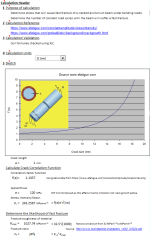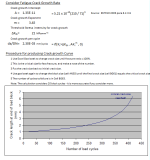Fracture and Fatigue Calculator.xls

Description
- Stress-Induced Fast Fracture: Identify the stress level that triggers an immediate fracture in an aluminum beam with a crack, under bending loads.
- Load Cycle Analysis: Ascertain the count of constant load cycles leading to a fast fracture in the beam.
Reference for Calculation
Validation of Calculation
- Validation Method: Utilization of XLC to verify cell formulas.
Calculation Procedure
Input Parameters
- Crack Length
- Applied Stress
Calculation Steps
- Crack Correlation Factor Function: Compute the function correlating the crack.
- Stress Intensity Factor: Determine the factor indicating stress intensity.
- Fast Fracture Probability: Evaluate the probability of encountering a fast fracture.
- Material’s Fracture Toughness: Identify the fracture toughness inherent to the material.
- Fracture Ratio: Calculate the ratio representing the fracture.
Incorporate Fatigue Crack Growth Rate Analysis
- Crack Growth Intercept
- Crack Growth Exponent
- Threshold for Crack Growth Stress Intensity
- Per Cycle Crack Growth
Crack Growth Curve Development Procedure
- Critical Crack Size Determination: Utilize Excel's Goal Seek to modify the crack size until the fracture ratio reaches 100%, noting the critical size for fast fracture.
- Initial Crack Size Reset: Revert the crack size to its initial measurement.
- Block Size Adjustment: Employ Goal Seek once more to alter the block size until the final crack size equals the critical crack size.
- Failure Cycle Count: The number of cycles leading to failure will be displayed in Cell BG63.
Note: The calculation takes into account 20 block cycles; accuracy may be enhanced by considering additional cycles.
Reference Topics
- Fracture Mechanics
- Mechanics and Mechanisms of Fracture
- Fatigue and Fracture
-
The theory behind the calculation revolves around Fracture Mechanics and Fatigue Crack Growth, particularly in materials like aluminum under bending loads. Here's a summarized breakdown:
1. Fracture Mechanics:
- Stress Intensity Factor (SIF): It quantifies the stress distribution around a crack tip, influencing the crack propagation. The SIF is crucial in predicting at what stress level a crack will propagate, leading to failure.
- Fracture Toughness: It is the critical stress intensity factor beyond which rapid fracture occurs. It quantifies a material's resistance to fracture and is crucial in determining whether a material with a known crack will fail under a specific load.
2. Fatigue Crack Growth:
- Crack Propagation: Under cyclic loading, a crack can grow due to the stress concentration at the crack tip. The crack growth rate is influenced by the applied stress and the material's inherent properties.
- Paris Law: Often used to describe crack growth due to cyclic loading, relating the crack growth rate to the SIF range.
- Crack Growth Rate (da/dN): It is defined as the crack growth per cycle, which can be determined using empirical formulas like Paris Law.
- Threshold Stress Intensity: The minimum stress intensity range below which the crack growth is negligibly slow.
3. Fast Fracture:
- Critical Crack Size: When a crack reaches a particular size, it can cause fast fracture, especially if the applied stress intensity exceeds the material’s fracture toughness.
- Fracture Ratio: It is the ratio of the applied stress intensity to the material's fracture toughness, and when it reaches 100%, fast fracture is imminent.
4. Calculation Procedure:
- Crack Correlation Factor: It is used to correlate the stress intensity factor with the applied stress and crack size.
- Likelihood of Fast Fracture: Determined by comparing the applied stress intensity with the material’s fracture toughness.
- Crack Growth Curve: It is developed by iteratively adjusting the crack size and block size using goal seek until the fracture ratio equals 100% and the final crack size equals the critical crack size, respectively.
5. Practical Application:
- Excel Goal Seek: Utilized to iteratively find the critical crack size and determine the number of cycles to failure by adjusting input variables to achieve desired output.
6. Note:
- The theory assumes that the material is isotropic and homogeneous, and linear elastic fracture mechanics (LEFM) applies. The calculation's accuracy is influenced by the consideration of the number of block cycles.
The theory and calculations aim to predict the life expectancy of a cracked aluminum beam under bending loads, ensuring structural integrity and safety in engineering applications.
Calculation Preview
Full download access to any calculation is available to users with a paid or awarded subscription (XLC Pro).
Subscriptions are free to contributors to the site, alternatively they can be purchased.
Click here for information on subscriptions.



